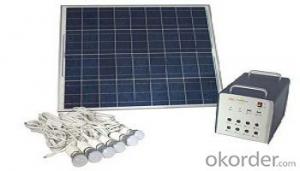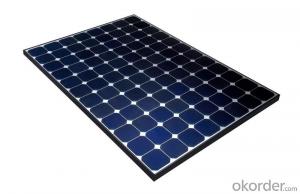Building Integrated Solar Energy Systems - CNBM On Grid System 5000W with Certificate UL, TUV, CE
- Loading Port:
- Shanghai
- Payment Terms:
- TT OR LC
- Min Order Qty:
- 100 watt
- Supply Capability:
- 1000 watt/month
OKorder Service Pledge
OKorder Financial Service
You Might Also Like
Specification
CNBM On Grid System 5000W with Certificate UL TUV CE
Product description
They range from small residential and commercial rooftop systems to large utility-scale solar power stations. Unlike stand-alone power systems, a grid-connected system rarely includes an integrated battery solution, as they are still very expensive. When conditions are right, the grid-connected PV system supplies the excess power, beyond consumption by the connected load, to the utility grid.
Connection of the photovoltaic power system can be done only through an interconnection agreement between the consumer and the utility company. The agreement details the various safety standards to be followed during the connection.[4]
Systems such as Net Metering and Feed-in Tariff which are offered by some system operators, can offset a customers electricity usage costs. In some locations though, grid technologies cannot cope with distributed generation feeding into the grid, so the export of surplus electricity is not possible and that surplus is earthed.
Grid-connected PV systems are comparatively easier to install as they do not require a battery system.[1][6]
Grid interconnection of photovoltaic (PV) power generation systems has the advantage of effective utilization of generated power because there are no storage losses involved.[7]
Grid-connected PV can cause issues with voltage regulation. The traditional grid operates under the assumption of one-way, or radial, flow. But electricity injected into the grid increases voltage, and can drive levels outside the acceptable bandwidth of ±5%.[8]
Grid-connected PV can compromise power quality. PV’s intermittent nature means rapid changes in voltage. This not only wears out voltage regulators due to frequent adjusting, but also can result in voltage flicker.[9]
Connecting to the grid poses many protection-related challenges. In addition to islanding, as mentioned above, too high levels of grid-connected PV result in problems like relay desensitization, nuisance tripping, interference with automatic reclosers, and ferroresonance.[10]

Application
Industrial
Commercial
Residential
Feature
Residential, grid-connected rooftop systems which have a capacity more than 10 kilowatts can meet the load of most consumers.[2] They can feed excess power to the grid where it is consumed by other users. The feedback is done through a meter to monitor power transferred. Photovoltaic wattage may be less than average consumption, in which case the consumer will continue to purchase grid energy, but a lesser amount than previously. If photovoltaic wattage substantially exceeds average consumption, the energy produced by the panels will be much in excess of the demand. In this case, the excess power can yield revenue by selling it to the grid. Depending on their agreement with their local grid energy company, the consumer only needs to pay the cost of electricity consumed less the value of electricity generated. This will be a negative number if more electricity is generated than consumed.[3] Additionally, in some cases, cash incentives are paid from the grid operator to the consumer.
Packaging
With carton and box
- Q: Can solar energy systems be used for powering electric vehicle solar charging stations at highways?
- Yes, solar energy systems can certainly be used to power electric vehicle (EV) solar charging stations at highways. Solar power is a clean and renewable energy source that can be harnessed through photovoltaic (PV) panels. These panels convert sunlight into electricity, which can then be used to charge EVs. Highways are often exposed to ample sunlight, making them ideal locations for solar charging stations. By utilizing solar energy, these charging stations can operate off-grid, reducing dependence on traditional power sources and minimizing environmental impact. Additionally, solar charging stations can be installed along highways without the need for extensive infrastructure development, as they do not require connection to the electrical grid. Solar-powered EV charging stations offer several benefits. First, they provide a sustainable and carbon-free method of charging EVs, helping to reduce greenhouse gas emissions and combat climate change. Second, they contribute to the development of a decentralized energy system, as they are independent of the electrical grid. This decentralization can enhance energy security and resilience, as well as increase the overall reliability of the charging infrastructure. Moreover, solar charging stations can have economic advantages. As the cost of solar panels continues to decrease and the efficiency of PV technology improves, the installation and maintenance costs of solar charging stations are becoming increasingly competitive with traditional charging infrastructure. Furthermore, solar charging stations can generate additional revenue through excess energy production, as any surplus electricity can be sold back to the grid. In conclusion, solar energy systems are a viable and sustainable solution for powering electric vehicle solar charging stations at highways. They offer environmental benefits, promote energy independence, and can contribute to cost savings. As the adoption of EVs continues to grow, the integration of solar energy into the charging infrastructure will play a crucial role in creating a greener and more sustainable transportation system.
- Q: Can solar energy systems be used in areas with high levels of bird or wildlife activity?
- Yes, solar energy systems can be used in areas with high levels of bird or wildlife activity. While there may be concerns about potential bird or wildlife interactions, various measures can be implemented to mitigate these risks. These can include using bird-friendly designs for solar panels, such as reducing reflective surfaces or installing netting to deter birds from nesting. Additionally, strategic placement of solar panels away from crucial wildlife habitats and using proper monitoring and maintenance protocols can help ensure the coexistence of solar energy systems and wildlife activity.
- Q: Can solar energy systems be used in off-grid locations?
- Yes, solar energy systems can be used in off-grid locations. In fact, they are an excellent solution for providing electricity in remote areas where access to the power grid is limited or non-existent. Off-grid solar energy systems can generate electricity through photovoltaic panels and store it in batteries for use during times when the sun is not shining. This enables individuals and communities in off-grid locations to have a reliable and sustainable source of energy.
- Q: Can solar energy systems be used for powering remote sensing or surveillance equipment?
- Yes, solar energy systems can be used effectively for powering remote sensing or surveillance equipment. Solar panels can convert sunlight into electricity, providing a sustainable and reliable power source for such equipment in remote locations. This eliminates the need for grid connection or reliance on traditional energy sources, making solar energy an ideal choice for powering surveillance or remote sensing systems.
- Q: What is the role of a solar energy system installer?
- The role of a solar energy system installer is to design, install, and maintain solar energy systems for residential, commercial, and industrial properties. They assess the site, conduct energy audits, determine the system size and components needed, and then install the solar panels, inverters, and other equipment. Additionally, they ensure proper electrical connections, perform system testing, and provide customer education on system operation and maintenance.
- Q: Can solar energy systems be used in areas with frequent lightning strikes?
- Yes, solar energy systems can be used in areas with frequent lightning strikes. However, it is essential to take proper precautions to protect the system from potential damage caused by lightning strikes. This can be achieved by using lightning arrestors, surge protectors, and grounding systems to minimize the risk of electrical surges and ensure the safety and integrity of the solar energy system.
- Q: How does the size of a solar energy system affect its installation cost?
- The size of a solar energy system directly affects its installation cost. Larger solar energy systems typically require more solar panels, inverters, and other equipment, which in turn increases the overall cost of installation. Additionally, larger systems often require more complex mounting systems and electrical wiring, which can further contribute to the installation cost. However, the cost per watt of a solar energy system generally decreases as the system size increases. This is because larger systems benefit from economies of scale, allowing for bulk purchasing of materials and reduced labor costs. As a result, the cost per watt decreases, making larger systems more cost-effective in terms of installation. Furthermore, the size of the solar energy system also impacts the amount of energy it can generate. Larger systems have a higher capacity and can produce more electricity, making them suitable for fulfilling higher energy demands. This can be advantageous for homeowners or businesses with larger energy consumption, as they can offset a greater portion of their electricity bills. It is important to note that the specific installation cost of a solar energy system depends on various factors such as location, equipment quality, labor costs, and available incentives. Therefore, while size is a significant factor, it is not the sole determinant of the installation cost.
- Q: Can a solar energy system be installed in areas with high pollution levels?
- Solar energy systems can be installed in areas with high pollution levels. Although pollution can decrease the efficiency of solar panels, it does not entirely hinder their functionality. Even in polluted areas, solar panels can still produce electricity, albeit with slightly lower output compared to cleaner environments. It is important to note that pollution can lead to the accumulation of dust and dirt on the surface of solar panels, further reducing their efficiency. Regular cleaning and maintenance of the panels can help address this issue and ensure optimal performance. Moreover, the installation of solar energy systems in areas with high pollution levels offers additional benefits. By utilizing solar power instead of traditional fossil fuel-based sources, it can contribute to the reduction of overall pollution levels and improve long-term air quality. This can have positive effects on both human health and the environment. In conclusion, although pollution can affect the efficiency of solar energy systems, they can still be installed and generate electricity in areas with high pollution levels. Additionally, the adoption of solar power can aid in pollution reduction and enhance the overall environmental conditions in such areas.
- Q: What is the impact of snow on the performance of solar panels?
- The impact of snow on the performance of solar panels is generally negative. Snow accumulation on the surface of solar panels can block sunlight, reducing their efficiency and power output. Additionally, snow can create a layer of insulation, preventing the panels from generating electricity. However, the angle and tilt of the panels, as well as the temperature, can also influence the impact of snow.
- Q: Can solar energy systems be used in areas with protected wildlife habitats?
- Yes, solar energy systems can be used in areas with protected wildlife habitats. By carefully designing and installing solar panels, it is possible to minimize any potential negative impacts on the environment and wildlife. This can be achieved by considering factors such as panel placement, bird-friendly designs, and ensuring minimal disruption to the surrounding ecosystem. Additionally, solar energy systems offer a sustainable alternative to traditional energy sources, reducing the reliance on fossil fuels and their detrimental effects on wildlife habitats.
Send your message to us
Building Integrated Solar Energy Systems - CNBM On Grid System 5000W with Certificate UL, TUV, CE
- Loading Port:
- Shanghai
- Payment Terms:
- TT OR LC
- Min Order Qty:
- 100 watt
- Supply Capability:
- 1000 watt/month
OKorder Service Pledge
OKorder Financial Service
Similar products
Hot products
Hot Searches
Related keywords


























